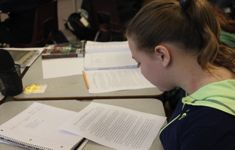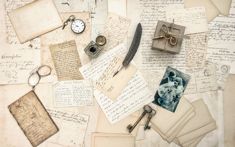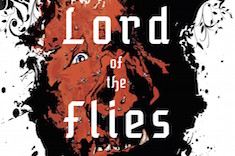“We are really quite concerned,” stressed the school counselor as she handed me the essay a student of mine had submitted for the state writing test. I smiled and even chuckled aloud at the student's attempt at satire, which was clearly influenced by Jonathan Swift’s essay “A Modest Proposal.” He both hit satire and, based on the counselor’s concern and the state readers who had red-flagged the essay, missed the satire mark. Although I agreed that the student was perhaps more graphic than needed in his essay “Why I Don’t Own a Dog,” I was heartened to know the essays we had read and analyzed in class had inspired him. When I met with him to discuss his essay, I shared my respect for his efforts, but also raised questions about some of his writing decisions. He concluded our conference by noting, “The problem with writing an essay based on satire is that if your reader doesn’t get the satire, they will think you are disturbed.” I suspect Jonathan Swift would concur.
Although it is not my goal to have students write essays that disturb readers, it is my goal to introduce students to essays that will push their thinking—about content and the craft of essays. I want students to discover that essays can be humorous, persuasive, informative, challenging, controversial, touching, and stylistically original. I want essays to serve as mentor texts for students so that they are inspired to do what Edwidge Danticat, editor of the 2011 edition in The Best American Essays series, describes about the essays she selected for inclusion, calling them “stories we dare tell others about ourselves.” She goes on to note that these stories “inform, instruct, and inspire. They might even entertain, but they can also strip bare, reducing (or expanding) the essence of everything we are to words."
Although I am a fan of teaching essays, I am also well aware of the challenge of finding essays to use with students that capture the “stripped-bare” essence Danticat describes.
Swift’s essay is one that has captured students’ interest—although I now share the story of my former student’s wisdom regarding the challenge of satire. I have listed here some of the essays, collections, and resources I turn to in support of essay exploration.
My “go-to” essay anthology is The Norton Sampler: Short Essays for Composition. I appreciate the weave of classic essays, including Jonathan Swift’s “A Modest Proposal,” E.B. White’s “Once More to the Lake,” Martin Luther King Jr.'s “I Have a Dream,” and Virginia Woolf’s “The Death of a Moth” with more contemporary essays, such as Garrison Keillor’s “A Sunday at the State Fair,” Nora Ephron’s “The Six Stages of E-mail,” and Geeta Kothari’s “If You Are What You Eat, Then What Am I?”
Although I am not a fan of categorizing essays by type, The Sampler does just that. "Humor and Satire" is one of the thematic categories. Swift is included, as is one of the authors most appreciated by the secondary students with whom I have worked: Dave Barry. Dave Barry writes nonfiction, in keeping with Common Core standards. But he writes humorous nonfiction, which reflects research findings on boys and literacy that calls for the inclusion of more humor in our literature curriculum. I have had great success using Dave Barry’s essay “Guys vs. Men” to explore issues about gender, culture, and language as well as writing craft: the use of definitions, analogies, the overall structure of an essay, and examples of humor and/or satire. I will admit to owning a number of Dave Barry’s essay collections, including his most recent, You Can Date Boys When You’re Forty: Dave Barry on Parenting and Other Topics He Knows Very Little About. I have found that public libraries appreciate the value of Dave Barry, so you could borrow his books and make a classroom set of an essay or two, in full compliance with copyright law.
Two additional library resources for essays are The Best American Essay series, edited by guest editors each year, and The Best American Nonrequired Reading series, edited by Dave Eggars. I note that Eggars works with high school students to scour publications looking for the “best” stories, essays, and comics to include in the annual publication. The students read, discuss, and present their case for inclusion, looking for writing that “loudly and eloquently” speaks about the year in which it was crafted (Eggars 2011, xii). One of my favorite essays in the series is “Roger Ebert: The Essential Man,” which originally appeared in Esquire magazine.
Girls also value humor in writing. They enjoy Dave Barry, but they also are fans of Sloane Crosley. Her essay “Le Paris” made the cut for The Best American Nonrequired Reading (2011). The opening line reads, “It’s incredibly difficult to get yourself banished from a city.” If you want more, Crosley has two essay collections, How Did You Get This Number and I Was Told There’d Be Cake. I recommend both.
In addition to the library, I rely on online resources. It’s been my experience that students appreciate seeing writing that is not in a book. For example, Leonard Pitts writes a column for the Miami Herald, which can be found online. He is skilled at examining recent events for the lessons we can learn. I appreciate how his writing style makes me feel like he is sitting at my dining room table talking. This past July he took on the issue of taking “selfies” in inappropriate places. I am confident students will have a response to Pitt’s essay in which he notes, ”we learn that it has become quite the modern ‘thing,’ people clowning, sticking out their tongues, lifting thumbs up, grinning like loons in somber and sacred places." The New Yorker is another great resource for essays that deal with current events. I have also had good success with essays from Entertainment Weekly, particularly Dalton Ross’s work. Stephen King used to write a column for this magazine, and I have had great success using his essays, particularly “Stephen King’s Guide to Movie Snacks." It is a great example of expository writing and humor.
Providing students with essays written by students is also important modeling of the value of essays. The Norton Sampler, noted above, has four student essays. I have also used Teen Ink. The This I Believe website is a great resource for student-authored essays (as well as essays from a variety of authors on a myriad of themes). This site also publishes student writing. I try to make it a habit to ask students for permission to make a copy of the essays they write in my classroom to share as mentor texts for their peers. Sometimes we take the next step and create a literary magazine of student writing.
James Moffett in Teaching the Universe of Discourse describes essays as “a candid blend of personal and universal.” It’s my hope that students will know this as readers and writers of essays.






